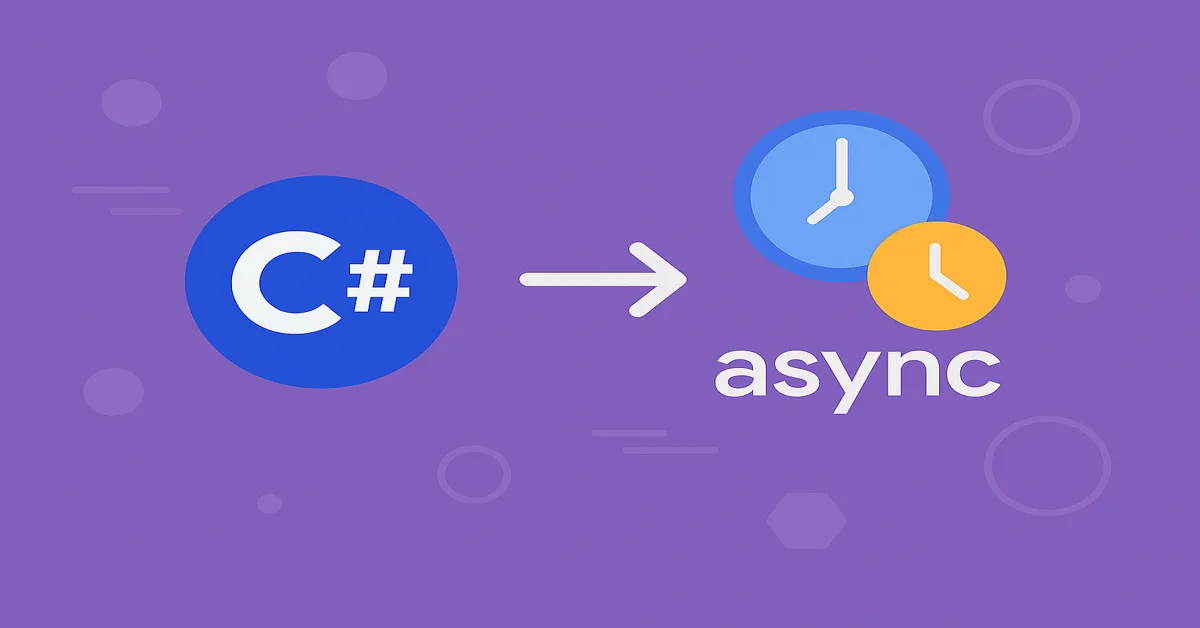In today’s software landscape, performance and responsiveness are not just technical luxuries—they are user expectations. Whether you’re building a web API that handles thousands of concurrent requests, a desktop app that must remain fluid under heavy computation, or a cloud-native service orchestrating remote data calls, blocking operations are the enemy of scale and responsiveness – Asynchronous Programming.
This is where asynchronous programming comes in—and in C#, the tools of the trade are async and await.
Asynchronous programming allows your application to perform time-consuming operations, such as I/O, network calls, and database queries, without freezing or blocking threads. It’s a style of programming that lets your application say, “This is going to take a while—let me know when you’re ready,” and then go off and do something else in the meantime.
This article is a comprehensive guide to mastering async and await in C#, written for developers who may understand the basics but want to confidently build robust, scalable, and responsive applications using these powerful language features. We’ll walk through not just the syntax, but also the patterns, the context, the caveats, and the philosophies behind async programming in .NET.
What is Asynchronous Programming?
Asynchronous programming is a technique that enables non-blocking operations. Instead of waiting for a task to complete, your code can register a continuation—“When this is done, then do this”—and keep going with other work.
In contrast to synchronous programming, where tasks are executed in a strict top-to-bottom order, async code frees up resources (especially threads) that would otherwise sit idle waiting for I/O.
This is particularly useful for:
- Web applications handling multiple requests
- Desktop apps avoiding UI freezes
- Cloud functions and APIs dealing with slow external services
The Basics of async and await in C#
C# introduced async and await in .NET Framework 4.5 and C# 5.0. These keywords work together to simplify asynchronous code using Tasks.
Task-Based Asynchronous Pattern (TAP)
At the core of async programming in C# is the Task object, part of the System.Threading.Tasks namespace. A Task represents an ongoing operation and can be awaited.
Let’s start with a basic example:
csharpCopyEditpublic async Task<string> GetDataAsync()
{
await Task.Delay(1000); // Simulates async work
return "Data retrieved";
}
Breaking It Down
asyncmarks the method as asynchronous.awaittells the method to pause until the operation is complete, without blocking the calling thread.- The method returns a
Task<string>instead of juststring.
Writing Your First Async Method
Let’s write a simple console app to demonstrate an asynchronous operation:
csharpCopyEditusing System;
using System.Threading.Tasks;
class Program
{
static async Task Main(string[] args)
{
Console.WriteLine("Starting...");
string result = await GetMessageAsync();
Console.WriteLine(result);
Console.WriteLine("Done.");
}
static async Task<string> GetMessageAsync()
{
await Task.Delay(2000); // Wait for 2 seconds asynchronously
return "Hello from async method!";
}
}
Output:
sqlCopyEditStarting...
(2-second pause)
Hello from async method!
Done.
The key here is that while GetMessageAsync() is delayed for 2 seconds, the thread is not blocked. If this were a UI app, the interface would still be responsive.
The Anatomy of async/await
Let’s explore the most common scenarios:
1. Returning a Value
csharpCopyEditpublic async Task<int> GetNumberAsync()
{
await Task.Delay(1000);
return 42;
}
2. Returning Nothing
csharpCopyEditpublic async Task LogAsync()
{
await Task.Delay(500);
Console.WriteLine("Logged!");
}
3. Synchronous Methods Calling Async Methods
This is where things get tricky. You should not call .Result or .Wait() on async methods inside synchronous code. It can cause deadlocks.
Incorrect:
csharpCopyEditstring data = GetDataAsync().Result; // Risky!
Correct:
Use await in an async method, or restructure the calling method to be async.
Why Threads Matter (or Don’t)
One of the most common misconceptions about async programming is that it uses multiple threads. In reality:
- Async does not create new threads.
- It frees up the thread while waiting on I/O.
- Continuations are resumed using a synchronization context, such as the UI thread in a desktop app.
This is why async is not synonymous with parallelism—it’s about efficiency, not concurrency in the traditional sense.
Best Practices for Async Programming
✅ Use async all the way
Once you start using async in a call chain, follow it through.
csharpCopyEdit// Good
public async Task ProcessDataAsync()
{
var data = await GetDataAsync();
await SaveDataAsync(data);
}
❌ Avoid async void
Except for event handlers, always return Task or Task<T>. async void methods can’t be awaited or caught in try-catch blocks.
✅ Use ConfigureAwait(false) in libraries
If you’re writing a library, use ConfigureAwait(false) to avoid deadlocks and unnecessary context switches:
csharpCopyEditawait Task.Delay(1000).ConfigureAwait(false);
This tells the runtime that you don’t need to resume on the original thread (like a UI thread).
Real-World Use Case: Calling an API
csharpCopyEditusing System.Net.Http;
using System.Threading.Tasks;
public async Task<string> GetGitHubApiAsync()
{
using HttpClient client = new HttpClient();
HttpResponseMessage response = await client.GetAsync("https://api.github.com/users/octocat");
response.EnsureSuccessStatusCode();
string content = await response.Content.ReadAsStringAsync();
return content;
}
Things to note:
HttpClient.GetAsync()is asynchronous and non-blocking.awaitallows your code to pause and resume cleanly.- There’s no need for threads to be held up while the HTTP call completes.
Error Handling in Async Methods
Use try-catch blocks like you normally would:
csharpCopyEdittry
{
var data = await GetDataAsync();
}
catch (HttpRequestException ex)
{
Console.WriteLine("Network error: " + ex.Message);
}
If a method throws an exception during await, it bubbles up to the calling method, just like with synchronous code.
Cancellation with Async Methods
You can cancel long-running async tasks using CancellationToken.
csharpCopyEditpublic async Task DownloadFileAsync(CancellationToken cancellationToken)
{
await Task.Delay(5000, cancellationToken); // Can be cancelled mid-way
}
Pass the token to your async method and check for cancellation:
csharpCopyEditif (cancellationToken.IsCancellationRequested)
{
// Cleanup and exit
}
Use CancellationTokenSource to issue the cancellation.
Async and the UI: Keeping It Responsive
In desktop applications (WPF, WinForms), calling a blocking method can freeze the UI. Async/await prevents this:
csharpCopyEditprivate async void FetchDataButton_Click(object sender, EventArgs e)
{
FetchDataButton.Enabled = false;
var data = await GetDataAsync();
DisplayData(data);
FetchDataButton.Enabled = true;
}
The UI remains responsive, and the code looks like a simple top-down sequence.
Testing Async Code
Unit testing async methods is straightforward in modern frameworks like xUnit or MSTest.
csharpCopyEdit[Fact]
public async Task GetDataAsync_ReturnsData()
{
var service = new MyService();
var result = await service.GetDataAsync();
Assert.Equal("ExpectedValue", result);
}
Test frameworks understand async Task return types and handle them properly.
Async and Performance
Async code can improve scalability and responsiveness, especially in:
- Web APIs: Handle thousands of requests efficiently.
- Background services: Run concurrent workflows.
- I/O-bound apps: Avoid wasted resources waiting on external operations.
Note: For CPU-bound operations, use multithreading instead (e.g., Task.Run()), as async doesn’t speed up computation.
Common Pitfalls and Misconceptions
| Mistake | Problem |
|---|---|
Using .Result or .Wait() | Can cause deadlocks |
Using async void | Can’t await or catch exceptions |
Ignoring ConfigureAwait(false) | Can lead to context-related bugs |
| Assuming async means multi-threading | It’s about freeing up threads, not adding more |
| Not handling exceptions | Async methods can fail silently if not awaited |
Future of Async in C#
C# continues to evolve. New language features like:
- ValueTask
- Async streams (
await foreach) - Minimal APIs and async handlers
…have made it easier than ever to write clean, asynchronous applications.
.NET’s integration of async with nearly all modern APIs ensures that asynchronous programming is no longer advanced—it’s essential.
Conclusion
Mastering asynchronous programming with async and await is not just a technical milestone—it’s a conceptual one. It forces us to think differently about time, concurrency, and execution flow. But once you adopt the async mindset, you’ll find your applications becoming more scalable, responsive, and modern.
Whether you’re writing a UI app that must remain snappy or a web service expected to handle high load, understanding how to use async and await is one of the most important skills a modern C# developer can have.
Start small, experiment with examples, and gradually adopt async patterns throughout your codebase. The rewards—in performance, user experience, and maintainability—are well worth it.
Read:
C# for Absolute Beginners: Writing Your First Console Application
Getting Started with LINQ in C#: A Beginner’s Guide
Authentication and IAM in GCP for C# Applications: A Comprehensive Developer’s Guide
FAQs
1. What’s the difference between Task, Task<T>, and void in async methods?
Task: Used when the async method performs an operation but doesn’t return a value.Task<T>: Used when the async method returns a result of typeT.void: Reserved for event handlers. Avoid usingasync voidelsewhere as it cannot be awaited or caught in try/catch blocks.
2. Can async methods run in parallel automatically?
No.async enables asynchronous (non-blocking) execution but not necessarily parallel execution. If you want multiple tasks to run concurrently, use:
csharpCopyEditawait Task.WhenAll(task1, task2);
Or start multiple tasks and await them later. Use Task.Run() for CPU-bound parallelism.
3. What is ConfigureAwait(false) and when should I use it?
ConfigureAwait(false) tells the runtime not to capture the current synchronization context, which avoids unnecessary overhead and potential deadlocks—especially in library code or background services.
Use it when you don’t need to resume on the original context (like a UI thread).
4. How do I cancel an async operation in C#?
Use CancellationToken. Pass it to async methods that support cancellation:
csharpCopyEditpublic async Task DoWorkAsync(CancellationToken token)
{
await Task.Delay(5000, token); // Supports cancellation
}
Call CancellationTokenSource.Cancel() to request cancellation.
5. Why does calling .Result or .Wait() on async methods cause issues?
Calling .Result or .Wait() blocks the current thread, which can lead to deadlocks—especially in UI applications or ASP.NET where there’s a synchronization context.
Always prefer await to asynchronously wait for completion:
csharpCopyEditvar result = await GetDataAsync();











